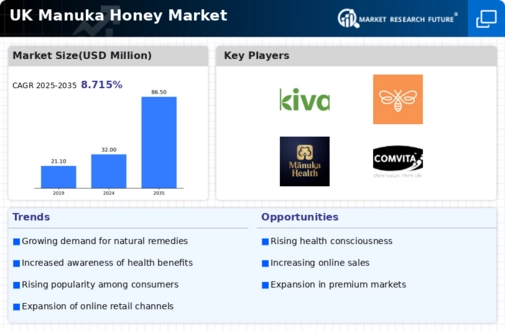Rising Consumer Awareness
The UK is experiencing a notable increase in consumer awareness regarding the health benefits of manuka honey.. This awareness is driven by extensive marketing campaigns and educational initiatives that highlight its antibacterial properties and potential therapeutic uses. As consumers become more informed, they are increasingly seeking out manuka honey for its purported health advantages, which has led to a surge in demand. Recent data indicates that the market has grown by approximately 15% in the last year alone, reflecting a shift in consumer preferences towards natural and functional foods. This trend is likely to continue, as more individuals prioritize health and wellness in their dietary choices, thereby propelling the manuka honey market forward.
Increased Online Retailing
The manuka honey market in the UK is witnessing a significant shift towards online retailing, which is reshaping how consumers access these products. E-commerce platforms have become essential channels for manuka honey sales, providing consumers with convenient access to a wide range of brands and product types. Recent statistics suggest that online sales of manuka honey have increased by over 20% in the past year, driven by the growing trend of online shopping. This shift not only enhances consumer convenience but also allows brands to reach a broader audience. As digital marketing strategies evolve, the manuka honey market is likely to see continued growth through online channels, making it a critical driver of market expansion.
Premium Product Positioning
The manuka honey market in the UK is characterized by its premium product positioning, which significantly influences consumer purchasing behavior. Manuka honey is often marketed as a luxury item due to its unique properties and limited availability, particularly from New Zealand. This premium status allows producers to command higher prices, with some varieties retailing for over £50 per kg. The perception of manuka honey as a high-quality, exclusive product appeals to health-conscious consumers willing to invest in their well-being. As the market continues to expand, brands are likely to emphasize the quality and authenticity of their products, further solidifying the premium positioning of manuka honey in the UK market.
Growing Demand for Natural Remedies
The manuka honey market in the UK is experiencing a surge in demand for natural remedies, as consumers increasingly seek alternatives to conventional pharmaceuticals. This trend is driven by a growing preference for holistic health solutions and a desire to avoid synthetic ingredients. Manuka honey, known for its natural antibacterial and anti-inflammatory properties, is being embraced by consumers as a viable option for various health issues, including sore throats and digestive problems. Market analysis indicates that the demand for natural health products, including manuka honey, has risen by approximately 18% in the last year. This growing inclination towards natural remedies is likely to continue influencing the manuka honey market, as consumers prioritize health and wellness in their purchasing decisions.
Regulatory Support for Natural Products
The manuka honey market in the UK benefits from regulatory support that promotes the use of natural products in food and health sectors. Government initiatives aimed at encouraging the consumption of natural and organic foods have created a favorable environment for manuka honey producers. This support is reflected in policies that facilitate the certification and labeling of natural products, ensuring that consumers can make informed choices. As the demand for natural health products rises, the manuka honey market is poised to capitalize on this trend, with regulatory backing enhancing consumer trust and product credibility. This supportive regulatory framework is likely to play a crucial role in the sustained growth of the manuka honey market.















Leave a Comment